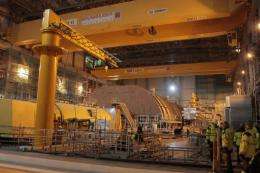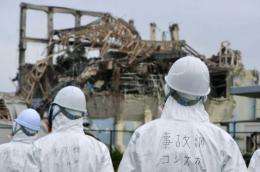Fukushima raises questions about new Finnish reactor

More than 5,000 hard-hat workers swarm over a sprawling nuclear facility in western Finland to build OL3 -- touted as the safest nuclear reactor in the world -- a claim which has come under scrutiny following Japan's nuclear disaster.
"Fukushima raised questions. The first one of course is whether such extreme natural phenomena have been taken into account here," says Jorma Sandberg, the head of risk analysis at Finland's Nuclear Safety Authority (STUK).
Japan's deadly earthquake and tsunami and subsequent nuclear disaster have sparked a world-wide re-assessment of reactor safety measures, prompting for instance Germany's decision to phase out all its nuclear reactors within the next decade.
In Finland, scrutiny falls especially on the construction of OL3, which raises questions because it will be the first so-called third generation reactor.
"It's true it has all the newest systems, but we don't know much about them in the sense that they haven't been used before, especially all the automation there," Sandberg says.
Critics like Greenpeace are calling for immediate structural changes, which they say can be made easily while the plant is still being built.
Most of the construction is done however, and the domed reactor core building is rising slowly over Olkiluoto island.
Thousands labour in its labyrinth of corridors and scaffolding, turning 320,000 cubic metres of concrete and five times the Eiffel Tower's steel into what, according to power company TVO, will be the most advanced nuclear reactor the world has ever seen.
"OL3 has taken safety planning further than any other nuclear reactor. There are the parallel systems, separate systems, duplicated systems, so that even if something happens that we hadn't thought of ... we can catch up to the problem and manage it," says Esa Mannola, the head of nuclear safety at TVO.
TVO, which runs two of Finland's four existing reactors, commissioned French nuclear specialist Areva to build OL3 based on cutting-edge third generation European Pressurised Reactor (EPR) technology.
But since the nuclear disaster at Fukushima, critics like Greenpeace have been demanding immediate structural changes to OL3 to address concerns raised by the disaster.
"The backup generators should not be at sea-level or at the same level as the reactors, and the control room of the nuclear power plant should be far enough away from the reactor that radiation from an accident would not prevent people from going there," insists Greenpeace energy expert Jehki Haerkoenen, listing some of the elements that contributed to Japan's accident.
The disaster left nearly 25,000 people dead or missing, and knocked out cooling systems at the Fukushima nuclear power plant, leading reactors to overheat and triggering the worst nuclear crisis since Chernobyl 25 years ago.

In a post-Fukushima risk survey released May 16, the nuclear safety agency STUK concluded there were no immediate changes needed to OL3.
The agency said however it was looking at whether access to the Olkiluoto reactors or any of its numerous backup systems could be prevented by severe storms, heavy snowfall, floods, or other natural phenomena native to Finland.
If any changes are recommended, it would likely further delay OL3's construction, which is already running years late and reportedly billions of euros (dollars) over budget.
The reactor was initially supposed to be operational in 2009, but TVO says now it won't be hooked up to the electricity grid until the beginning of 2013.
TVO's Mannola meanwhile insists the Fukushima accident is not likely to spark any major changes to OL3.
In addition to having four completely separate backup power solutions, where Fukushima had only two per reactor, OL3's reactor building can withstand the impact of a plane and also contain most of the radiation if the core were to melt, he says.
Greenpeace's Haerkoenen however maintains that spent fuel, which he says is poorly protected at OL3, is just as dangerous as active fuel rods.
"Used uranium should be protected in the same way as the reactor," he says, saying changes like this will be "practically impossible" once the reactor is in use.
Much of the main machinery is already in place, such as the two giant steam generators that loom over the massive hole that constitutes the reactor pressure vessel -- the space that will eventually hold 320 tonnes of enriched uranium.
Sandberg of STUK says the level of safety at OL3 looks good, but said more study is needed.
"What we need is to look at these issues in peace, and not leap to conclusions," he says.
(c) 2011 AFP
















